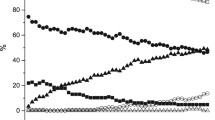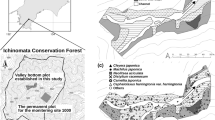Abstract
Species-habitat association analysis is useful to detect spatial arrangement of individual plants, to discover rules about the distribution of species and to generate hypotheses about the possible underlying process controlling observed structures. Quantifying methods were used to classify habitats in terms of topographical variables in a mixed temperate broad-leaved Korean pine forest of the Changbai mountains in northeastern China. All of the 625 20 m × 20 m quadrats of the plot could be unambiguously assigned to one of three habitat categories (low-plateau, high-plateau and slope). Torus-translation tests were used to estimate species-habitat associations. Many species are clearly distributed in a biased fashion with respect to habitats. Fifteen (55.6%) out of 27 species showed strong positive or negative association with specific habitats. We compared species-habitat associations at the sapling and adult stages. Adjusted density values indicated few species exhibit extremely strong habitat associations. Only 9 out of 26 species had adjusted densities > 3 in the habitat for which they had strong positive affinity. Few species show the same associations at the small tree and large tree stages. Only 3 out of 22 occurring associations with a specific habitat appeared to have a consistent habitat association at the two stages. These results suggest that species-habitat associations exist in the 25-ha plot of the temperate forest of the Changbai mountains. Owing to limitations in our statistical methodology, we partly underestimated associations by ignoring rare species. Regeneration niches can contribute to co-existence, but regeneration niches due to habitat associations play a limited role in species co-existence, since most species show a similar trend in habitat associations at the sapling and adult stages. We should pay more attention to shifts in habitat associations, i.e. niche shifts at different stages of existence.
Similar content being viewed by others
References
Aiba S, Kitayama K, Takyu M. 2004. Habitat associations with topography and canopy structure of tree species in a tropical montane forest on Mount Kinabalu, Borneo. Plant Ecol, 174: 147–161
Beatty S W. 1984. Influence of microtopography and canopy species on spatial patterns of forest understory plants. Ecology, 65 (5): 1406–1419
Cheng B R, Xu G S, Ding G F. 1981. The main soil groups and their properties of the Natural Reserve on northern slope of Changbai Mountain. Res Forest Ecosyst, 2: 196–206 (in Chinese with English abstract)
Chi Z W, Zhang F S, Li X Y. 1981. The primary study on water-heat conditions of forest ecosystem on northeast slope of Changbai Mountain. Res Forest Ecosyst, 2: 167–178 (in Chinese with English abstract)
Clark D B, Clark D A, Read J M. 1998. Edaphic variation and the mesoscale distribution of tree species in a neotropical rain forest. J Ecol, 86: 101–112
Comita L S, Condit R, Hubbell S P. 2007. Developmental changes in habitat associations of tropical trees. J Ecol, 95: 482–492
Condit R, Ashton P S, Baker P, Bunyavejchewin S, Gunatilleke S, Gunatilleke N, Hubbell S P, Foster R B, Itoh A, LaFrankie J V, Seng Lee H, Losos E, Manokaran N, Sukumar R, Yamakura T. 2000. Spatial patterns in the distribution of tropical tree species. Science, 288(5470): 1414–1418
Condit R, Hubbell S P, Foster R B. 1994. Density dependence in two understory tree species in a neotropical forest. Ecology, 75(3): 671–680
DeWalt S J, Ickes K, Nilus R, Harms K E, Burslem D F R P. 2006. Liana habitat associations and community structure in a Bornean lowland tropical forest. Plant Ecol, 186: 203–216
Grubb P J. 1977. The maintenance of species-richness in plant communities: the importance of regeneration niche. Biol Rev, 52: 107–145
Gunatilleke C V S, Gunatilleke I A U N, Esufali S, Harms K E, Ashton P M S, Bunslem D F R P, Ashton P S. 2006. Specieshabitat associations in a Sri Lankan dipterocarp forest. J Trop Ecol, 22: 371–384
Hao Z Q, Li B H, Zhang J, Wang X G, Ye J, Yao X L. 2008. Broad-leaved Korean pine (Pinus Koraiensis) mixed forest plot in Changbaishan (CBS) of China: community composition and structure. J Plant Ecol, 32: 238–250 (in Chinese with English abstract)
Harms K E. 1997. Habitat-specialization and seed-dispersal limitation in a neotropical forest. Dissertation for the Doctoral Degree. Princeton: Princeton University
Harms K E, Condit R, Hubbell S P. 2001. Habitat associations of trees and shrubs in a neotropical forest. J Ecol, 89: 947–959
Hubbell S P, Foster R B. 1983. Diversity of canopy trees in a neotropical forest and implications for conservation. In: Sutton S J, Whitmore T C, Chadwick A C, eds. Tropical Rain Forest: Ecology and Management. Oxford: Blackwell Science, 25–41
Hubbell S P, Foster R B. 1986. Canopy gaps and the dynamics of a neotropical forest. In: Crawley M J, ed. Plant Ecology. Oxford: Blackwell Science, 77–96
Kuželová I, Chytrý M. 2004. Interspecific associations in phytosociological data sets: how do they change between local and regional scale? Plant Ecol, 173: 247–257
Leigh E G J. 1999. Tropical Forest Ecology: a View from Barro Colorado Island. Oxford: Oxford University Press
Paoli G D, Curran L M, Zak D R. 2006. Soil nutrients and beta diversity in the Bornean Dipterocarpaceae: evidence for niche partitioning by tropical rain forest trees. J Ecol, 94: 157–170
Pulliam H R. 1988. Sources, sinks, and population regulation. Am Nat, 132: 652–661
Graf R F, Bollmann K, Suter W, Bugmann H. 2005. The importance of spatial scale in habitat models: capercaillie in the Swiss Alps. Landscape Ecol, 20: 703–717
R Development Core Team. 2005. Royal: a Language and environment for statistical computing. R Foundation for Statistical Computing, Vienna, Austria
Roxburgh S H, Chesson P. 1998. A new method for detecting species associations with spatially autocorrelated data. Ecology, 79(6): 2180–2192
Schupp E W. 1995. Seed-seedling conflicts, habitat choice, and patterns of plant recruitment. Am J Bot, 82: 399–409
Sri-Ngernyuang K, Kanzaki M, Mizuno T, Noguchi H, Teejuntuk S, Sungpalee C, Hara M, Yamakura T, Sahunalu P, Dhanmanonda P, Bunyavejchewin S. 2003. Habitat differentiation of Lauraceae species in a tropical lower montane forest in northern Thailand. Ecol Res, 18: 1–14
Svenning J C. 1999. Microhabitat specialization in a speciesrich palm community in Amazonian Ecuador. J Ecol, 87: 55–65
Svenning J C. 2001a. Environmental heterogeneity, recruitment limitation and the mesoscale distribution of palms in a tropical montane rain forest (Maquipucuna, Ecuador). J Trop Ecol, 17: 97–113
Svenning J C. 2001b. On the role of microenvironmental heterogeneity in the ecology and diversifi cation of neotropical rain-forest palms (Arecaceae). Bot Rev, 67: 1–53
Tilman D, Pacala S W. 1993. The maintenance of species richness in plant communities. In: Richlefs R E, Schluter D, eds. Species Diversity in Ecological Communities: Historical and Geographical Perspectives. Chicago: University of Chicago Press, 13–25
Valencia R, Foster R B, Villa G, Condit R, Svenning J, Hernandez C, Romoleroux K, Losos E, Magard E, Balslev H. 2004. Tree species distributions and local habitat variation in the Amazon: large forest plot in eastern Ecuador. J Ecol, 92: 214–229
Webb C O, Peart D R. 2000. Habitat associations of trees and seedlings in a Bornean rain forest. J Ecol, 88: 464–478
Werner E E, Gilliam J F. 1984. The ontogenetic niche and species interactions in size-structured populations. Ann Rev Ecol Syst, 15: 393–425
Yamada T, Tomita A, Itoh A, Yamakura T, Ohkubo T, Kanzaki M, Tan S, Ashton P S. 2006. Habitat associations of Sterculiaceae trees in a Bornean rain forest plot. J Veg Sci, 17: 559–566
Yamada T, Suzuki E. 1999. Changes in spatial distribution during the life history of a tropical tree, Scaphium macropodum (Sterculiaceae) in Borneo. J Plant Res, 110: 179–186
Zhao D C. 1980. The altitudinal distribution belts of vegetation on Changbai Mountain. Res For Ecosys, 1: 65–70 (in Chinese with English abstract)
Author information
Authors and Affiliations
Corresponding author
Rights and permissions
About this article
Cite this article
Ye, J., Hao, Zq., Xie, P. et al. Habitat associations of saplings and adults in an old-growth temperate forest in the Changbai mountains, northeastern China. For. Stud. China 13, 13–22 (2011). https://doi.org/10.1007/s11632-011-0103-0
Received:
Accepted:
Published:
Issue Date:
DOI: https://doi.org/10.1007/s11632-011-0103-0




